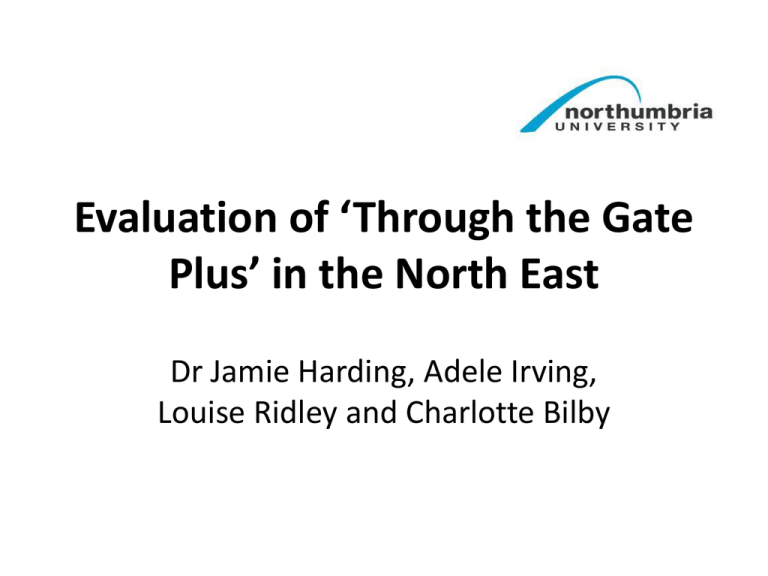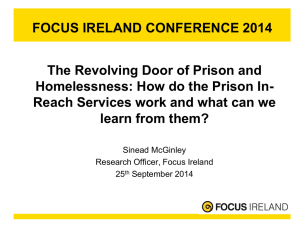here - Northumbria
advertisement

Evaluation of ‘Through the Gate Plus’ in the North East Dr Jamie Harding, Adele Irving, Louise Ridley and Charlotte Bilby Through the Gate Plus (TTGP) • • • • November 2012 – November 2014 Delivered by Foundation. Referrals provided by Shelter. Primary aim: To reduce homelessness among offenders. Criteria – 18+, custody in NE prison, risk of homelessness, – History of homelessness/housing problems, prolific offending, complex needs. • Pre-release and (13 week) post-release support – Ending/maintaining tenancies; pre-tenancy training; supporting access to housing; facilitating access to broader services. • 651 prisoners referred for support Nov 2012 – June 2014 • 352 supported Evaluation • Assess the effectiveness of the TTGP Service delivery model from staff and service user perspectives. • Understand the specific approaches to service delivery of Shelter and Foundation. • Assess the distance-travelled by service users in respect of housing, offending and key risk factors. • Identify gaps in service provision. • Identify key learning points for future support services. Methodology • Two semi-structured interviews with Shelter staff. • Two focus groups with Foundation staff (autumn 2013); follow-up focus group (summer 2014). • Analysis of statistical data provided by Foundation. • 44 client questionnaires (12.5% of total supported) • Two semi-structured interviews with service users in prison, fourteen with service users in the community and one with a service user’s partner. Shelter and Foundation Services • Shelter assesses the housing needs of all prisoners; Foundation works with particular categories of chaotic/high risk prisoners. • Shelter works with prisoners throughout sentences; Foundation work’s with prisoners close to release. • The work of Shelter stops at the gate of the prison, Foundation’s service continues into the community. • Shelter regards their strongest links as being with Newcastle and Sunderland, Foundation has longer established relationships in County Durham. • Shelter has peers, mentors and volunteers involved in their services, Foundation’s work is conducted by staff and volunteers. The Referral Process • 33 of 42 (78.6%) referrals came from Shelter (78.6%) • In 38 of 43 cases (88.4%), Foundation’s work with service users began in custody. – In 19 of 36 cases (52.8%), work began less than one week before release. ‘… some of the clients that are probably more chaotic are your ones that come in on very short sentences and have a very quick turnaround…the timescales make it extremely challenging for us to see them, then to do the referral’ (Shelter) ‘Durham get a lot of 28 days sentences so…they don’t actually have the notice themselves’ (Foundation) ‘[Prison], they just had a massive backlog, it’s such a busy prison…they kind of work month to month...’ (Foundation) • Doubling of prison population since 1993; high volume of short term sentences (62,000 per year) and high levels of re-offending. Characteristics and Background of Service Users • 42 of 44 (95.4%) were male. • Mean age 37. • Referrals - Holme House 37.2% , Northumberland 32.6% and Durham 18.8%. • Mean sentence 14 months. • Two pathways to exclusion – ‘Life long’ and ‘life events’. – 7 of 16 reported chaotic childhoods. – 7 of 11 left school without qualifications. – ASB, substance misuse, criminality. – Up to 20 prison stays, spanning 15 years. – Complex social relationships. – Mental health problems. Offending, Homelessness and Addictions ‘I went to prison when I was 15…car thieving. I’ve been taking drugs since I was about 16, when my mam and da split up’ ‘Going everywhere, begging people, what you can to stay there. Just doing what you can to survive, isn’t it?’ ‘I believe that my crimes were all down to being homeless…I’ve never even had a house before’ ‘Prison, on and off, since 2000. I would say probably a quarter of my life I’ve been homeless’ Experiences of Prison ‘When I was getting out of prison, I was thinking it would snowball again. I would end up back in prison…’ ‘I was shitting myself because my time was coming to end and that, you know what I mean, it was like six weeks before I was getting out’ ‘I was, yeah, because I thought I was just gonna go in some rubbish place. I just thought I was gonna be brushed aside and put wherever’ ‘I knew if I didn’t get somewhere, I’d be going, I’d end up back inside’ ‘I didn’t know, really. I mean, I thought I was just gonna be in a hostel’ Likely Housing Situations on Release Without Intervention Likely Housing Situation Number of service users Percentage Homeless 23 53.5% Sofa surfing 10 23.3% Staying with friends 3 7.0% Staying with family long term 3 7.0% Staying with family short term 2 4.7% Possibly staying with partner 2 4.7% Total 43 100% Applications for Housing Organisation applied to Number of respondents Local authority / local authority housing options 25 (80.6%) Supported housing 15 (48.4%) Private landlords 9 (29.0%) Housing association 3 (9.7%) Barriers to Housing Barrier Number of respondents Addictions 25 (59.5%) Mental health problems 11 (26.2%) Rent arrears 6 (14.3%) Anti-social behaviour 5 (11.9%) Physical disabilities / physical health problems 4 (9.5%) Public hostility 3 (7.1%) Other 5 (11.9%) The Application Process • Perception that social rented housing was not an option ‘Getting knock back after knock back after knock back’ ‘…’Cause when you get done for drugs, it’s more or less a nono with the council, you know what I mean’. • Proactive approach taken by Foundation staff • Service users acknowledged value of support ‘She’s got me a place here which is brilliant, ‘cause I don't think I would have got nowhere without them…’ Initial Housing Situation First housing situation Total Private rented property 9 (23.7%) Bed and breakfast hotel or guest house 7 (18.4%) Staying with family or friends 6 (15.7%) Supported accommodation 4 (10.5%) Shared accommodation 4 (10.5%) Living with partner 2 (5.3%) Sofa surfing Hostel Own flat (tenure unspecified) 2 (5.3%) 2 (5.3%) 1 (2.6%) Slept rough Total 1 (2.6%) 38 (100%) Final housing situation Final housing situation Private rented property Supported accommodation Own flat (tenure unspecified) Staying with family Hostel Shared accommodation Living with partner Total Total 15 (39.5%) 9 (23.7%) 5 (13.2%) 5 (13.2%) 2 (5.3%) 1 (2.6%) 1 (2.6%) 38 (100%) Comparison of Housing Situation With and Without Support • 33 cases where service users were judged to have had no stable housing situation without intervention • 27 supported to move to a long term housing solution – 13 to private rented property, 8 to supported accommodation, 6 to own flat (tenure unspecified) Service users’ views of final housing situation • Some pleased to have been moved to a different area. • Many pleased with property. ‘It’s put a smile on my face, you know what I mean, It’s a cracking little - well, it’s not at all little. It’s got a nice kitchen, back yard, you know what I mean’. ‘I’d have gone anywhere but coming to Darlington, it’s out the way, it’s a fresh start and I love it here.’ ‘No-one knows where we live so it’s lush’. • Concerns over quality of private rented property. Difficulties in working with social landlords / local authorities • Different perceptions about demand from released prisoners in their area. • Floating support is often being cut. • Benefit restrictions cause difficulties across all tenures. • Timely interviews problem across all tenures. • Supported housing offers continuing support beyond the 13 weeks that Foundation can provide. Other Forms of Support Form of support Number of service users Collecting from prison 10 (31.3%) Ensuring attended appointments 7 (21.9%) Helping with benefits (including Housing Benefit) 7 (21.9%) Supplying food 6 (18.8%) Liaising with/referring to other agencies 6 (18.8%) Helping to find furniture 5 (15.6%) Regular visits and calls 4 (12.5%) Helping to obtain bond for private tenancy 4 (12.5%) Pre-tenancy work 3 (9.4%) Helping to register with GP and dentist 3 (9.4%) Other Forms of Support • • No target for many forms of support. Material help particularly valued ‘I’ve got a washer. I’ve got a fridge and freezer through [Foundation worker] and she’s helped me get furniture. She’ got me drawers, beds’ ‘I mean I had nowt…to help me get furniture and food and stuff like that. It was a surprise actually because I didn’t think I’d get any.’ • Personalisation fund particularly helpful. • Help to access health care & services for addictions also important. • Value of emotional support, rebuilding confidence ‘It was nice to have the support from Foundation when I initially got out, until you get your confidence back’ 13 weeks support ‘The 13 weeks? I think it should be longer because I didn’t really get this place until about 13 weeks, so 13 weeks is up and then they’re just plonking you in a house, and then what do you do from there?’ ‘Well, for me, the first time I’ve had my own house, I think it’s a bit of a short time. You know, I would really appreciate a little bit more time’ ‘It worries me a bit like, if after 13 weeks I’m still not sorted out, I’m not gonna have that back up there’ Impact of Support • Most service users judged to be managing ‘very well’ or ‘well’ in their housing situation. • Some had re-offended. • Other ambitions expressed such as improving relationships with family and finding work. • Support and housing situation linked by offenders to desistance; feeling they had ‘something to lose’. ‘If it wasn’t for her [Foundation worker], he’d have been back in jail by now’ ‘[Without the support of Foundation, it would] just be back the way it was’ ‘The main thing was my housing. If I got my housing, then I’m laughing’. Key findings • Timescales a key difficulty for all agencies • Few service users had secure housing situations to return to • Successes in re-housing people in supported housing, although concerns over reasons • Success in re-housing people in PRS, although concerns over quality • Limited engagement with social landlords • Material support highly valued Future commissioning recommendations • CRCs need to find ways to discuss housing options earlier in sentence. • CRCs need to encourage good practice among all local authorities and social housing providers to ensure that social rented housing is a realistic option • CRCs need to have the capacity to provide effective housing support for as long as it is needed after release







